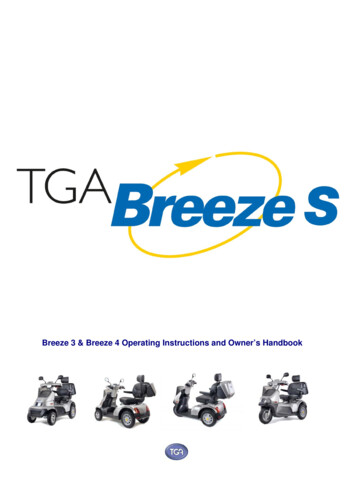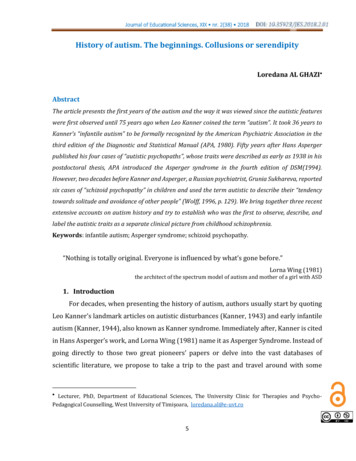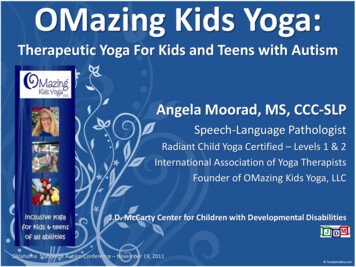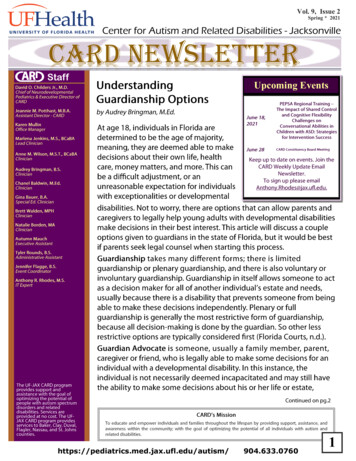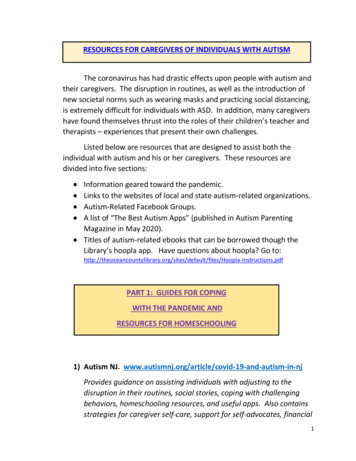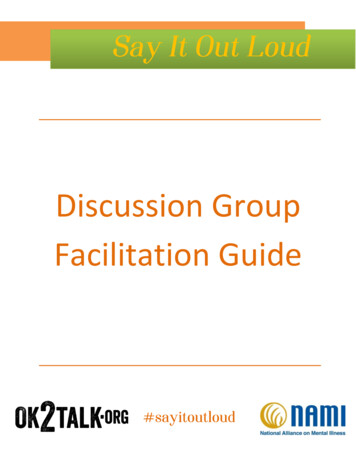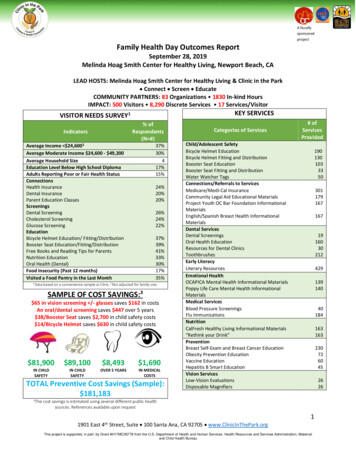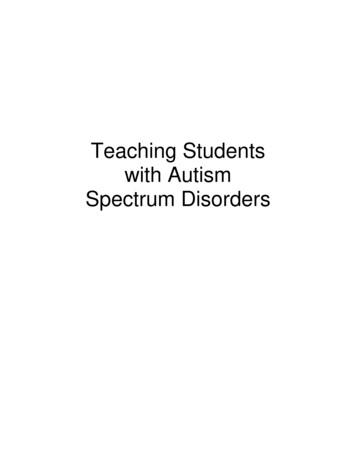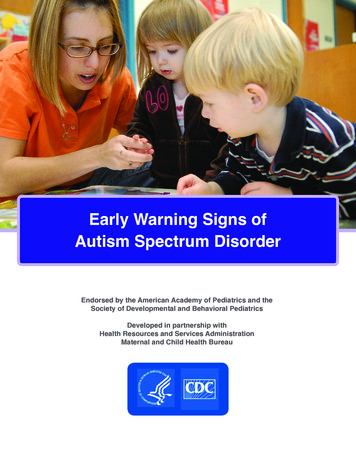
Transcription
Early Warning Signs ofAutism Spectrum DisorderEndorsed by the American Academy of Pediatrics and theSociety of Developmental and Behavioral PediatricsDeveloped in partnership withHealth Resources and Services AdministrationMaternal and Child Health Bureau
Early Warning Signs of Autism Spectrum DisorderAbstractAt a family function, your cousin asks your advice about the development of her 2-year-old son. She has noticed thathe has a hard time communicating, is rigid in his behavior, and often has temper tantrums. Her pediatrician does notseem very concerned, but she wants your opinion given that you are working in pediatrics.Case GoalEarly warning signs alert providers to the risk of a possible autism spectrum disorder (ASD). Recognizing thesewarning signs is necessary in order to know when to screen or further evaluate children for ASD and how toappropriately counsel families. After completion of this module, learners will be able to:1.2.Identify key social-emotional and language milestones through 24 months of ageRecognize the major early warning signs of ASDThree Steps to Prepare - In 15 Minutes or Less!1Read through the Facilitator’s Guide and make copies of the case and learner worksheet for distribution.2Identify the key topics you wish to address. Consider:-3Knowledge level of learnersAvailable timeYour familiarity with the subjectSelect and prepare the optional teaching tools you wish to use. Each case provides a variety of optionalmaterials to enhance the learning environment, support facilitator style, focus on different themes, oraccommodate different time limitations. These materials are optional for facilitators to use at their discretion.-Handouts: select any you wish to use and make copies for distribution-Video: review embedded video and video library, decide if you wish to use, confirm necessary technicalequipment, and conduct test run-PowerPoint: decide if you wish to use and confirm necessary technical equipmentThe following case was developed by the authors. Itdoes not necessarily reflect the views or policies of theDepartment of Health and Human Services (HHS) or theCenters for Disease Control and Prevention (CDC).Developed in partnership withHealth Resources and Services AdministrationMaternal and Child Health Bureau.Autism Case Training:A Developmental-Behavioral Pediatrics Curriculum1
Early Warning Signs of Autism Spectrum DisorderKey Learning Points of This Case1.2.Identify key social-emotional and language milestones through 24 months of agea.Describe typical social skills that are present in children from birth through 24 months (Prompt1.1 andHandout I: First Signs Hallmark Developmental Milestones)b.Identify expected language milestones from birth through 24 months (Prompt 1.3 and Handout III: YourChild at 2 Years)c.Identify expected play skills by age (Prompt 2.1 and Handout V: Play Skills)Recognize the major early warning signs of ASDa.Identify key red flags for ASD (Prompt 2.3 and Handout VI: Red Flags of ASD)b.Recognize the difference between a typical temper tantrum and one of a child with an ASD (Handout IV:Temper Tantrums)Only Have 30 Minutes to Teach? :30Focus your discussion on recognizing typical and atypical behavior and development, particularly social and playmilestones, as well as the red flags of ASD. Use: Handouts: III Your Child at 2 Years and VI Red Flags of ASDVideos: “Response to Name” and “Nathan & Ben Playing”Potential Prompts: 1.3 and 2.3Materials Provided Case Worksheet for LearnersThe Case Study: Part I, II, and III (available in Facilitator’s Guide and on CD)Optional Teaching Tools PowerPoint with Embedded Videos (available on CD) Handouts (available in Facilitator’s Guide and on CD) Handout I: First Signs Hallmark Developmental Milestones Handout II: Shy Temperament vs. ASD Handout III: Your Child at 2 Years Handout IV: Temper Tantrums Handout V: Play Skills by Age Handout VI: Red Flags of Autism Spectrum DisordersVideo Library (available on CD)*References*There are many potential videos for this case in the video library that demonstrate red flags and milestones.Please review the library for additional videos.Case AuthorsLiz Harstad, MD, Children’s Hospital Boston, Harvard Medical SchoolCarol Baum, MD, Warren Alpert Medical School of Brown UniversityYvette Yatchmink, MD, PhD, Warren Alpert Medical School of Brown UniversityEditorsGeorgina Peacock, MD, MPH, National Center on Birth Defects and Developmental Disabilities, Centers for Disease Control and PreventionCarol Weitzman, MD, Yale University School of MedicineJana Thomas, MPA, Porter NovelliAutism Case Training:A Developmental-Behavioral Pediatrics Curriculum2
Early Warning Signs of Autism Spectrum DisorderGetting StartedThis case is designed to be an interactive discussion of a scenario residents may encounter in their practices.Participation and discussion are essential to a complete learning experience. This Facilitator’s Guide providespotential prompts, suggestions for directing the discussion, and ideas for incorporating the optional teaching tools.It is not designed as a lecture.Case study icons:Early Warning Signs of Autism Spectrum DisordersDistribute “CaseStudy Part I”Case Study Part ICall-out: step-by-step teaching instructionsNote: tips and clarificationSlide: optional slide, if using PowerPointYou are attending a family reunion and during a quiet moment, your cousin Elizabethtakes you aside and asks you what you think about the development of her son, Mark.She tears up as she tells you how worried she is about him. Mark will be 2 years old nextmonth, and he seems so different from the other children on the playground. Although heis an affectionate and happy little boy, his behaviors can be so unpredictable. He is veryshy and has terrible temper tantrums. It is usually impossible to reason with him. Smallchanges in his routine throw Mark off, and Elizabeth is worried that he won’t be able tohandle the crowd at this family gathering without causing a scene. You ask her what herpediatrician thinks.Slide 3Elizabeth tells you that Mark has been seen by his pediatrician, and she has expressedher concerns about his temper tantrums on a few visits. Mark enjoys going to thedoctor’s office because they have a large tropical fish tank, and he has generally beencalm in that setting. Mark’s doctors have all been very reassuring, and think he has abad case of the “terrible twos.” The doctor has told her to “give him some time; he is stillyoung and will likely grow out of this phase.”You have been preoccupied by your relatives, and you honestly haven’t been payingtoo much attention to Mark. You know that your cousin is a doting and caring mother.Elizabeth and her husband, Sam, had fertility struggles, and she was thrilled to give birthto Mark after a grueling course of in-vitro fertilization treatments. You know that Mark wasborn full term without any complications. You heard that he was a fussy baby, but that hewas otherwise healthy.Case Study Part I: Discussion QuestionFilmstrip: optional slide contains an embedded videoPaper: potential place to distribute an optional handout:30Digital clock: tips if you only have ‘30 Minutes to Teach’Slide 4After reading the case, ask participants, “What stands out to you about themother’s concerns?”Follow up withstudent responsesto encourage morediscussion:Case Study Part I: Potential Prompts1.1What are some key developmental milestones for ages 6 months to 4 years?1.2It is evident that Elizabeth is concerned about Mark’s “shy” manner. What are typicalsocial skills that most children obtain by 12 months? By 18 months? By 24 months?1.3How can you determine the difference between a child with a shy temperament and achild with an autism spectrum disorder?1.4As you begin to ask Elizabeth about her son, what other developmental milestonesdo you want to consider?1.5How could you address Elizabeth’s concern about Mark’s temper tantrums?1.6What are the strengths of this child and family? What in the casesupports that? Why do youthink that? What makes yousay that?:304Autism Case Training:A Developmental-Behavioral Pediatrics CurriculumWhy is This Case Important?Evidence-based educational and interventional strategies can help children learn and buildcompetency in areas of need. Many of these strategies are most effective when introducedearly. It is important to be proactive regarding developmental concerns, and it is imperativepediatricians be able to detect early warning signs of developmental delays. In the UnitedStates, autism spectrum disorder (ASD) is usually diagnosed in children between 3 and 7 yearsof age. However, studies have shown that parents usually have concerns about their child’sdevelopment, especially social development, at or before 18 months of age.The risk factors for receiving a later diagnosis of an ASD include: Having many primary care providers rather than seeing one consistent provider Living in a rural area compared with an urban setting Living in a near-poor household versus a wealthy householdIntroduce thesession goaland format ofthe case studySlide 1-2Children who have severe language deficits and/or display the symptoms of hand flapping or toewalking are more likely to be diagnosed earlier.Cultural CompetenceIt is important for clinicians to understand how different childrearing practices and culturalnorms may influence key decisions that parents make regarding their child including obtainingevaluations and treatment, future planning, and acceptance of the child’s diagnosis. Clinicianscan approach parents openly and honestly by asking them about their unique style ofparenting and how the information or recommendations provided are received.See the curriculum introduction for additional information on cultural competence and potentialdiscussion questions.Autism Case Training:A Developmental-Behavioral Pediatrics CurriculumThis case does not takeplace in a clinical setting.This unique setting andthe role of the physicianin addressing familymedical concerns mayprovide an interestingline of discussion.3
Early Warning Signs of Autism Spectrum DisorderDistribute “CaseStudy Part I”Case Study Part IYou are attending a family reunion and during a quiet moment, your cousin Elizabethtakes you aside and asks you what you think about the development of her son, Mark.She tears up as she tells you how worried she is about him. Mark will be 2 years old nextmonth, and he seems so different from the other children on the playground. Although heis an affectionate and happy little boy, his behaviors can be so unpredictable. He is veryshy and has terrible temper tantrums. It is usually impossible to reason with him. Smallchanges in his routine throw Mark off, and Elizabeth is worried that he won’t be able tohandle the crowd at this family gathering without causing a scene. You ask her what herpediatrician thinks.Slide 3Elizabeth tells you that Mark has been seen by his pediatrician, and she has expressedher concerns about his temper tantrums on a few visits. Mark enjoys going to thedoctor’s office because they have a large tropical fish tank, and he has generally beencalm in that setting. Mark’s doctors have all been very reassuring, and think he has abad case of the “terrible twos.” The doctor has told her to “give him some time; he is stillyoung and will likely grow out of this phase.”You have been preoccupied by your relatives, and you honestly haven’t been payingtoo much attention to Mark. You know that your cousin is a doting and caring mother.Elizabeth and her husband, Sam, had fertility struggles, and she was thrilled to give birthto Mark after a grueling course of in-vitro fertilization treatments. You know that Mark wasborn full term without any complications. You heard that he was a fussy baby, but that hewas otherwise healthy.Case Study Part I: Discussion QuestionSlide 4After reading the case, ask participants, “What stands out to you about themother’s concerns?”Follow up withstudent responsesto encourage morediscussion:Case Study Part I: Potential Prompts1.1What are some key developmental milestones for ages 6 months to 4 years?1.2It is evident that Elizabeth is concerned about Mark’s “shy” manner. What are typicalsocial skills that most children obtain by 12 months? By 18 months? By 24 months?1.3How can you determine the difference between a child with a shy temperament and achild with an autism spectrum disorder?1.4As you begin to ask Elizabeth about her son, what other developmental milestonesdo you want to consider?1.5How could you address Elizabeth’s concern about Mark’s temper tantrums?1.6What are the strengths of this child and family?Autism Case Training:A Developmental-Behavioral Pediatrics Curriculum What in the casesupports that? Why do youthink that? What makes yousay that?:304
Early Warning Signs of Autism Spectrum DisorderSupporting Information for Potential Prompts1.1What are some key developmental milestones for ages 6 months to 4 years? 6 Months Responds to own name Responds to other people’s emotions and often seem happy Copies sounds Likes to play with others, especially parents12 Months Uses simple gestures, like shaking head “no” or waving “bye-bye” Says “mama” and “dada” and exclamations like “uh-oh!” Plays games such as “peek-a-boo” and “pat-a-cake” Responds to simple spoken requests18 Months Plays simple pretend, such as feeding a doll Points to show others something interesting Likes to hand things to others as play Says several single words24 Months Says sentences with two to four words Follows simple instructions Gets excited when with other children Points to things or pictures when they are named36 Months Shows affection for friends without prompting Carries on a conversation using two to three sentences Copies adults and friends Plays make-believe with dolls, animals, and people48 Months Tells stories Would rather play with other children than by themselves Cooperates with other childrenAutism Case Training:A Developmental-Behavioral Pediatrics Curriculum5
Early Warning Signs of Autism Spectrum Disorder1.2It is evident that Elizabeth is concerned about Mark’s “shy” manner. What are typicalsocial skills that most children obtain by 12 months? By 18 months? By 24 months? 6 months: Knows familiar faces and begins to know if someone is a stranger Likes to play with others, especially parents Responds to other people’s emotions and often seems happy Likes to look at self in mirror12 months Points and responds to name Is shy or nervous with strangers Cries when mom or dad leaves Has favorite things and people Shows fear in some situations Hands you a book when he wants to hear a story Repeats sounds or actions to get attention Puts out arm or leg to help with dressing Plays games such as “peek-a-boo” and “pat-a-cake”:30Slide 5Response toNameSlide 6Joint Attn.I. Hallmark Dev.Milestones18 months Likes to hand things to others as play May have temper tantrums May be afraid of strangers Shows affection to familiar people Plays simple pretend, such as feeding a doll May cling to caregivers in new situations Joint attention: expresses an enjoyment in sharing an object or event withanother person by looking back and forth between object and caregiver Explores alone but with parent close by24 months Copies others, especially adults and older children Gets excited when with other children Shows more and more independence Shows defiant behavior (doing what he has been told not to) Plays mainly beside other children, but is beginning to include other children,such as in chase gamesAutism Case Training:A Developmental-Behavioral Pediatrics Curriculum6
Early Warning Signs of Autism Spectrum Disorder1.3How can you determine the difference between a child with a shy temperament and achild with an autism spectrum disorder?II. Shy Temperamentvs. ASDShy children are hypervigilant, and scan the environment, although they avoid direct eyecontact with the examiner. However, they look up to the mother or caregiver for socialreferencing and hover around or cling to the caregiver.Children with an ASD are not vigilant and do not look up to the caregiver for socialreferencing. They may not cling to the caregiver, although go up to them for succor.However, some cling to the caregiver because of extreme anxiety.In general, shy children are shy in some environments, or with some people, and notwith others. Selective mutism and its partial forms can be challenging to differentiatefrom ASD.1.4SHY TEMPERAMENTAUTISM SPECTRUM DISORDERQuiet and withdrawn in new settingsLack of spontaneous seeking to share enjoyment,interests, or achievements with othersSlow to develop friends and play with othersFailure to develop peer relationshipsappropriate to developmental level; evenwith closest peers, prefers to play aloneTends to look away from others or look downMarked impairments in use of eye-to-eye gazeeven with familiar people and family membersTakes a long time to becomecomfortable in group settingsLack of emotional or social reciprocity, does notunderstand the back and forth of communicationAs you begin to ask Elizabeth about her son, what other developmental milestones doyou want to consider?Language Domain :30III. Your Child at2 Yrs.Points to things or pictures when they are namedKnows names of familiar people and body partsSays sentences with two to four wordsFollows simple instructionsRepeats words overheard in conversationPoints to things in a bookAutism Case Training:A Developmental-Behavioral Pediatrics Curriculum7
Early Warning Signs of Autism Spectrum DisorderBehavioral Domain Stands on tiptoeKicks a ballBegins to runWalks up and down stairs holding onClimbs onto and down from furniture without helpThrows ball overhandMakes or copies straight lines and circlesCognitive Domain/Play Behaviors Finds things even when hidden under two or three coversBegins to sort shapes and colorsCompletes sentences and rhymes in familiar booksPlays simple make-believe gamesBuilds towers of four or more blocksMight use one hand more than the otherFollows two-step instructions such as “Pick up your shoes and put them in thecloset”Names items in a picture book such as a cat, bird, or dogThese milestones are from the Centers for Disease Control and Prevention es/milestones-2yr.html and the First Signswebsite tm.1.5How could you address Elizabeth’s concern about Mark’s temper tantrums?Although temper tantrums are often a stage of normal development, if they are severeor persist beyond about 4 years of age, they may indicate a behavioral or developmentalproblem. Children who have difficulty communicating with others, or those with rigidexpectations, may have increased temper tantrums due to frustration. Temper tantrumsare often very disruptive and upsetting for parents; therefore, it is always important totake parents’ concerns about temper tantrums seriously. Talk to parents about strategiesfor decreasing the likelihood of temper tantrums and how to help their children stay safewhen tantrums do occur.1.6IV. TemperTantrumsWhat are the strengths of this child and family?It is always important to explore the strengths of a child with an autism spectrum disorderor developmental delays. Parents and clinicians may become so focused on the deficitsand, in some cases, the behavioral issues that a child is having, that they aren’t able tonotice what the child does well. By asking a family about what a child is good at, andwhat their positive traits are, one is able to frame recommendations for intervention andtreatment in the context of these strengths. In addition, asking about what a child likescan be used when discussing next steps. Finally, in addition to exploring the strengthsof the child, it is helpful to think about the strengths of the family and how these canbe used when discussing options and next steps for treatment. It is always helpful forAutism Case Training:A Developmental-Behavioral Pediatrics Curriculum8
Early Warning Signs of Autism Spectrum Disorderclinicians to take the time to note changes and improvements in functioning and positivefeatures of the child and narrate these observations to parents.Some of Marks’ strengths include: The child is described as affectionate and happyThe parent is known to be doting and caringMotor milestones were attained typicallyCognitively, the child appears to be bright – having learned many of his letters andan ability to count to 10 in SpanishHis mother perceives him to be a smart little boyCase Study Part I: Discussion QuestionSlide 7Before moving to Part II, ask participants, “What would you say to Elizabeth?”Case Study Part IIDuring your conversation, you find out that Mark attained his motor milestones typically.By 1 year of age, he was walking. Now he is climbing on everything. He has started torepeat words and, thanks to a beloved DVD, he has learned many of his letters and cancount to 10 in Spanish. You ask about how Mark communicates and gets what he wants.Elizabeth says that he is very smart and that he usually tries to get things himself. Shecannot recall a time that he pointed or gestured to get his needs met.Distribute “CaseStudy Part II”Slide 8At that moment, Mark wanders into the room. He starts to run back and forth whileverbalizing “fast, fast, fast.” You call him many times, but he doesn’t seem to hear you.Elizabeth says that he is a very busy, active boy and that he acts this way a lot. Hestops his playing and begins to spin the wheels of a toy train. You are beginning to getconcerned. These aren’t normal play behaviors. You even think back on your familyhistory and can’t recall anyone with an ASD.was otherwise healthy.Case Study Part II: Discussion QuestionsSlide 9After observing Mark, how has your initial reaction changed?Autism Case Training:A Developmental-Behavioral Pediatrics Curriculum9
Early Warning Signs of Autism Spectrum DisorderCase Study Part II: Potential Prompts2.1What are appropriate play skills for a child Mark’s age?2.2What are the concerning aspects of language development in this case, and what wouldyou optimally like to see in a child’s language skills by 24 months of age?2.3There are many red flags in Mark’s language, social, and behavioral profile. What arethe early warning signs for autism spectrum disorder?:30Supporting Information for Potential Prompts2.1What are appropriate play skills for a child Mark’s age? 2.2Uses objects symbolically; for example, uses a crayon to pretend to give baby abottleUses toys as complete objects rather than becoming preoccupied with one part ofthe toy V. Play SkillsPre-Speech: Communication delays consisting of the absence of speech areusually fairly obvious. However, more subtle abnormalities with pre-speech can beearly warning signs of an ASD. These include: lack of appropriate gaze lack of alternating back-and-forth babbling decreased use of pre-speech gestures (such as waving) lack of expressions such as “uh-oh”As children develop speech, early warning signs of an ASD include scripted speech,echolalia, and using words out of context.Scripted Speech: A child repeats a word or phrase he has heard elsewhere, suchas from a television program or movie. The child uses the phrase out of context, andit is not used in an attempt to communicate. Slide 10Nathan &Ben PlayingIs excited about the company of others and imitates the behaviors of othersWhat are the concerning aspects of language development in this case, and what wouldyou optimally like to see in a child’s language skills by 24 months of age? :30For example, when a child is asked, “How are you doing?” he may state, “Don’tworry, tomorrow we’ll be back for more frolic and fun,” which is a quote from atelevision show.Echolalia, sometimes called parroting: The repetition of someone else’s speech.When the repetition occurs immediately it is called “immediate” and when it occurshours, days, or weeks later it is called “delayed.” The child may repeat the speech inthe same intonation in which it was heard. An example of this is that the child may hear his mother say, “Do you wantjuice?” and then the child promptly says “juice?”Autism Case Training:A Developmental-Behavioral Pediatrics Curriculum10
Early Warning Signs of Autism Spectrum Disorder It is important to note that typically developing children often go through a period ofrepeating the last word or phrase they have heard during their normative explosionin word learning. One distinction is that the typically developing child will state“juice!” with an emphatic declarative intonation, while the child with an ASD will state“juice?” with the same questioning intonation that he heard. For typically developingchildren, the period of word repetition associated with the vocabulary boom may lastseveral months in the second year of life; for children with ASD, this word repetitionmay continue.Using words out of context (using “pop-up” words): Words are said without anycommunicative intent and without any stimulus. A child may use one “pop-up” wordfor several days or weeks and then stop using it. For example a child may state “train” several times per day for a period of time,and then, suddenly stop using the word. The child does not direct his speechtoward others when saying the “pop-up” word.For a typically developing 2-year-old child, you would like to see the child: 2.3Use language for communicative purposesUse and understand about 50 wordsSpeak spontaneously and use the words he knows to convey needs and desires toothersDirect his speech toward othersPut words together, into short phrases of two to four words in lengthAs he learns new words, he may briefly repeat them and then should quickly beginusing them on his own in the appropriate contextThere are many red flags in Mark’s language, social, and behavioral profile. What are theearly warning signs for autism spectrum disorder?:30The early warning signs for an ASD include concerns about a child’s social skills,communication, and restricted or repetitive patterns of behaviors, interests, activities,and emotional regulation.Some red flags Mark shows include: Lack of response to nameVI. Red Flagsof ASDDeficits in joint attentionInappropriate play with a toyLack of pointingIntolerance of changes in routine and scheduleSome other warning signs that indicate a child should be evaluated include:Impairment in: Social Interaction Inappropriate gaze Lack of warm, joyful expressionsAutism Case Training:A Developmental-Behavioral Pediatrics Curriculum11
Early Warning Signs of Autism Spectrum Disorder Lack of sharing interests Lack of response to contextual cues Lack of response to name Lack of coordination of nonverbal communication Impairment in communication Lack of showing Lack of pointing Unusual prosody Lack of communicative consonants Using a person’s hand as a toolRepetitive Behaviors & Restricted Interests Repetitive movements with objects Repetitive movements or posturing of body Lack of playing with a variety of toys Unusual sensory exploration Excessive interest in particular toysEmotional Regulation Distress over removing objects Difficulty calming when distressed Abrupt shifts in emotional states Unresponsive to interactionsDevelopmental or behavioral regression should always be taken seriously. Whenregression occurs in association with an ASD, motor skills are generally preserved.Developmental or behavioral regression describes a significant loss of previouslyacquired milestones or skills. Although some debate exists regarding the accuracy ofparental report regarding regression, it is generally believed that regression occurs in theminority of children with ASD. The mean age at which parents report autistic regressionis 20 months. The most frequently reported aspect of regression is loss of language,followed by loss of social-emotional connectedness.Case Study Part III EpilogueAfter thinking over milestones, early warning signs, and what you know of Mark’sbehavior, you do have concerns about Mark. You commend your cousin for picking upthese issues. Elizabeth tears up. She admits her sister thought it could be an ASD, butshe wasn’t sure. Why was this missed? Anyone who works with children is in a positionto make valuable observations about a child’s development, and they should be takenvery seriously. Learn the signs!Autism Case Training:A Developmental-Behavioral Pediatrics CurriculumDistribute “CaseStudy Part III Epilogue”Slide 1112
Early Warning Signs of Autism Spectrum DisorderCase Study Part III – Epilogue: Discussion QuestionHow would you apply the information in this case?What did you learn through this case?Case Study Part III – Epilogue: Potential Prompts3.1How does the conversation with Elizabeth end?3.2How involved does one get in a nonclinical situation? Does the pediatrician have anobligation to give the mother professional advice?Slide 12Supporting Information for Potential Prompts3.13.2How does the conversation with Elizabeth end? Do you discuss autism spectrum disorder?Do you recommend Elizabeth return to her pediatrician for the concern of autismspectrum disorder and ask for a referral to a specialist?How involved does one get in a nonclinical situation? Does the pediatrician have anobligation to give the mother professional advice? Clinicians will encounter this informal type of consultation throughout their careers. It isimportant to thoughtfully consider issues that may come up as a result of this. For instance: Acknowledge that this is a complex diagnostic workup and requires information,observation, and a team of professionals Consider whether you can be objective and whether your advice can beobjectively considered Consider other ethical and legal ramifications of your involvementPotential Next Case: “Screening for Autism Spectrum Disorder”Case GoalEarly identification
warning signs is necessary in order to know when to screen or further evaluate children for ASD and how to appropriately counsel families. After completion of this module, learners will be able to: 1. Identify key social-emotional and language milestones through 24 months of age 2. Recognize the major early warning signs of ASD
